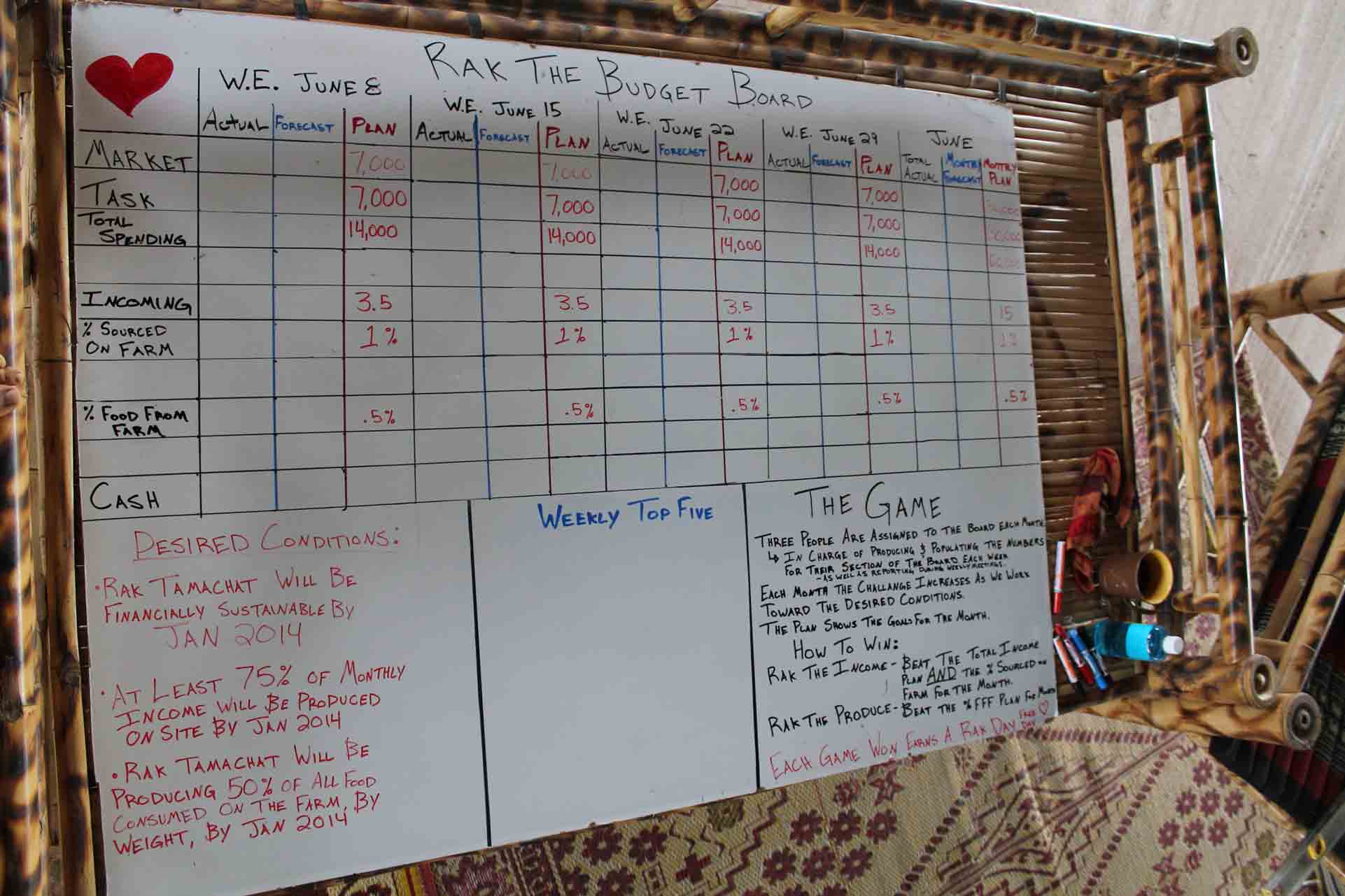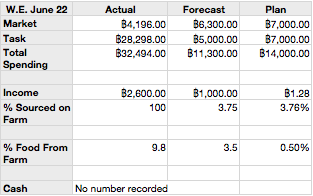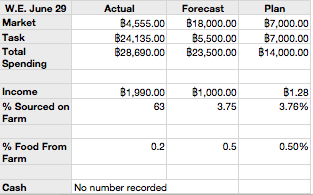When the final design came into practice the results, after only a few weeks of use, were astounding and greatly exceeded my expectations. Early results showed a great increase in understanding of financial goals and the means to achieve them; more comfort around financial tracking and the reasons for it; an energy of inspiration to meet and exceed goals; a burst in creative idea generation for financial growth; and a general feeling of cooperation toward a unified project vision.
The Game Begins
After designing the new scoreboard, Rak The Budget Board, it was time to get the community engaged. Because the plan was designed around monthly increments, as shown in the Rak Budget Plan spreadsheet, the implementation had to occur at the beginning of a new month. Fortunately I planned in advance and had a couple weeks to slowly introduce the new ideas before unavailing the final board design. This helped me to build alignment with the goals and get feedback to help insure I was on the right track before implementation.
As June, the month the new game was scheduled to begin, drew closer the anticipation for the unveiling of this new game grew. Finally, after the first week came to a close, we had our first chance to look at the design and see how we faired against the goals.
For the week ending June 8th, our goals were very easy to achieve. We only had to make 1.28 THB (about $0.04 USD), of which 3.76% was required to be produced on-farm. As for the food, we only needed to harvest .5% of the weight of food we consumed on the farm. At this point, however, we had not fully developed effective tools for tracking some of the new metrics. In order to track these new metrics we had to adjust our existing ledger book to account for the income sources and consider the means of production as well as start a new ledger book and buy a scale to begin weighing and tracking the food we harvested against what we purchased at the market.
Tracking systems
Because the previous board and, up until this point, the entire financial system had been completely managed and maintained by me, I wanted to use this new design as an opportunity to shift some of that responsibility and engage the community in the management systems that would ultimately determine the success of the project. To accomplish this, I broke the board into three different sections.
Spending
The first section was our spending and included the Market, Task and Total Spending lines. The person in charge of this section was tasked with totaling up our spending for the week from the ledger book based on those two basic categories, and populate the board with the appropriate information. They were also asked to highlight any areas that seemed unusual or of significant mention such as the highest transaction of the week or why we spent 20% more on food than a previous week, for example.
Income
The second section was the income section. This section had one of the two games attached to it. The person in charge of the section for that month simply had to track how much income was generated through various ventures that we created and determine how much of that income was sourced from the farm.
We decided at this point to leave out income from courses (in fact, we decided to leave course finances off the board entirely as it was an area that could potentially cause a great deal of confusion. Course financing was being handled completely differently at the time. My intention was to eventually fold this in under another section of the board with a separate set of goals but more time was needed to develop an appropriate system for course income).
Tracking income sources proved to be challenging and not a very straight forward process at all. At this point we resigned to taking a guess as we figured out ways to appropriately track source information. The person in charge of this line was also tasked with populating the information on the board and discussing the interesting points regarding our income during the weekly meetings.
Precent of Food From Farm
Third was the %FFF or, Precent of Food From Farm, section. For this section, a new ledger book was created and a scale was purchased to track the amount of food we harvested verses how much we bought at the market. The person in charge of this line would insure that people assigned to market runs would take the food ledger book with them and record the weights of items bought. This was easy enough, as most things purchased at the market were sold by the kilogram. Anything that was not sold by the kilo was simply put on the scales and recorded upon returning to the farm. The ledger book also recorded the weight of food we harvested. Every time we harvested something from the farm we would put it on the scale and record it in the ledger book.
I believe this is an incredibly valuable record to create. Having a picture of production rates over time and being able to monitor harvests through the seasons as a project grows and matures is hugely valuable from both an individual project standpoint and from the perspective of larger research on permaculture development. Creating a system of tracking these metrics with goals and incentives makes it that much more effective and also empowers people to see the fruits of their labor in a whole new way. This quickly became the most exciting development of this design project… and you’ll see more of why as you read on.
Cash on Hand
Lastly was the Cash on Hand section. Here it was simply necessary to count up the total cash we had available, both in our petty cash drawer and the bank account. With this number we could insure that we had cash flow enough to continue the project or recognize any shortages that would require careful spending. Being the most important aspect of the previous scoreboard, it was essential that this metric be carried over and tracked in addition to the new metrics.
Implementing a strategy that put the design of these tracking systems into the hands of the people assigned to the various sections was a great way to kickoff this new scoreboard. The community was instantly empowered to take charge of their role and develop a sense of ownership behind the game, its intentions and goals.
Early Results
After a little initial trepidation around fears of change and new responsibilities subsided I could immediately recognize a shift in the community’s understanding of our financial status and the goals associated with it. Hearing people talk about how much there was to harvest in the garden or how we should brew more kombucha for sale were clear indicators that the system was working. I could finally see some of the results that I had experienced durning the implementation of Open Book Management at Wheatsville Co-op.
Because we were still establishing tracking systems in the first week we had to simply estimate some numbers, specifically the Percent of Food From Farm. I didn’t want to start us out on the wrong foot, I knew that we had been harvesting some things from the farm that week, and our goal of .5% was so small that it made sense to go ahead and say that we probably had harvested at least that amount. Here are the results from the first week of use given such estimates:
As you can see, we performed quite well on our first week. We had 500 THB of income that was 100% produced on farm (that percentage was suspect on further review but we let it slide).
As mentioned already, we simply put .5% for our %FFF metric with the idea that we were likely pretty close to that figure. (I, myself, with foresight into the game, had harvested as much as I could for that week.)
The initial results were very promising. Already we were winning on at least one of the two games and our spending was lower than budgeted. More promising was the awareness that seemed to be developing around the new goals.
Week 2
The next week our %FFF tracking system was fully online and we started to get a picture of where we were in regard to how much we were actually harvesting from the farm. Previous to this game, it had been noted that ripe mangoes and fallen off the tree and rotted on the ground without a second thought. The issue was one of awareness.
the power of indicators
Some years ago I had read an interesting article by Donella Meadows called Indicators and Informations Systems for Sustainable Development where she referenced an interesting study that showed how electrical meters placed in a common walkway resulted in greatly reduced electrical usage to those same meters, in otherwise identical houses, being placed in the basement. The revelation was that simple access to the right indicators was a major motivator for changes in behavior.
After only the second week of implementation of this new Open Book Management design I was beginning to see this same effect surface. Simply by having access to the information (the amount of food we harvested on the farm) behaviors were starting to shift.
Whereas, previously, we would buy all our food at the market and pile it in the kitchen for use, we suddenly had a new set of information to think about, a new goal. The market food, being so close to where we cooked our meals was easily accessible. The food we grew in the garden was like the electric meter being placed in the basement. It was so far from where we used it that harvesting food from the garden typically happened as an after thought. Thus, mangoes were left to rot under the tree.
Suddenly, as the new tracking system went into effect and the information was available for everyone to see, harvesting food from the garden became the priority. The first thing someone thought when they were tasked with cooking for that day became “I wonder what I can harvest from the garden” instead of, “there’s all this food from the market that I need to use up before it goes bad (so we have to buy more)”.
The results begin to show for themselves as the game progressed. Here are the results of week two:
The second week gave a picture of where we were with a little increased awareness. On this week we were once again ahead on the income game and, even though we spent dramatically more on food (as we had made a large bulk purchase of flour, rice and sugar for the month) we had still managed to meet our forecast of harvesting 1% from the farm (fairly accurately at that!).
Considering the amount of increased weight purchased in bulk that week… this was a huge victory!
Week 3
Finally in full swing, I was feeling a large weight lifting off my shoulders. My role in finances was becoming more manageable as more people took on responsibility and began to gain clarity around our goals and how they could be achieved.
Week three showed the best results yet:
A huge increase in Task spending as we paid for dorm bedding to prepare for our upcoming courses. We also had the very first wave of course participants arrive near the end of the week with a fresh batch of kombucha to greet them. The result was a huge increase in our income. (the percent produced on farm still suspect as we discussed ways to determine this metric with complex products). Perhaps again the most exciting increase was in the %FFF where we nearly harvested 10% of the weight in food we used in the kitchen from the farm! When I designed this game, I was worried that our goals would be a little too ambitious and planning to have 50% of our food come from the farm within two years was going to be a huge challenge. Now I was beginning to wonder if that was too easy!
Week 4
By the fourth week from the implementation of this new design it was clear we were winning on many levels.The weeks that followed became a challenge of a new sort as we had a local chef come in to cook for our courses. She had no interest in maintaining our tracking systems and did the market shopping herself. We were also challenged by the disruption the course brought to our daily routines and we found it difficult to keep up with the financial board during these chaotic times.
Many things were also in a state of flux for me personally as I was preparing to facilitate my own Permaculture Design Course (see Project 2), starting a consultation project in Hua Hin, managing course finances, and making arrangements to hand off management responsibilities.
Despite all the challenges, week four still showed impressive and promising results:
These numbers we knew were not 100% accurate but it was important to maintain the game and so we pushed on.
Here we found that our food spending was way below what we expected, but only because we had not yet paid our Chef in full. Our Task budget continued to come in way over plan and forecast but much of this money was spent on long term project development such as the dorms and course materials that would later be reimbursed by the course fees.
Our Income line continued to out perform the plan and forecasts as we were able to sell plenty of home-brewed Kombucha and Ginger Beer to our visiting students. We also were able to finally come up with a system to help us track how much of the income made was sourced from the farm. By our early estimate we were already close to the end goal of 75% of income produced on farm! What an exciting number to see at such an early stage of a new program.
Our %FFF was expectedly low, as mentioned. We still took every opportunity to deliver food harvested from the farm to the kitchen and get estimates from our local Chef about how much weight she bought of various things at the market. Although our number here is probably not perfectly accurate it was a good attempt and showed a real drive in the community to make the best of a challenging situation.
Conclusion
By the end of the month it was clear that we had won on many fronts. Most importantly, we had won the first month of challenges and we awarded the community with Free Day Tokens. Unfortunately, after all their hard work, the internship had come to a close. Old interns were moving on and new interns were beginning to arrive and settle in. This transition, in the midst of two back-to-back courses and a new financial system, along with many other new challenges (such as another dramatic change in funding from the project owner) made this program very difficult to move forward. Because I was also transitioning out of my managerial role at this time it seemed unlikely that the Open Book Management program would continue on as designed here.
I did my best to pass on the knowledge we had gained from using this model but, without sustained practice, it was of no use. I left to do a consultation in Southern Thailand and then to teach my first Permaculture Design Course in Austin, Texas and the scoreboard went into the closet. I will cover more about the victories and failures of this design the Evaluation section of this project. Suffice to say, I was happily surprised with the victories of this short run design and I’ve been inspired to teach this system wherever I can!
When I created the initial design I thought I was being overly ambitious. Making a goal of financial sustainability in less than 3 years of any project’s creation is asking a lot. After one month, it was clear to me that this design concept holds one of the keys to quickly launch any project into financial self-sufficiency in a surprisingly short timeframe. I will be working to refine and hope to expand this model into many new areas in the very near future.






